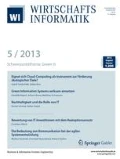Literatur
Bancilhon, F.: Object-Oriented Database Systems. In: Proceedings of ACM SI GACT/SIGMOD Symposium on Principles of Database Systems. ACM, New York 1988, S. 152–162.
Bohrer, K.: Middleware Isolates Business Logic. In: Object Magazine 7 (1997) 9.
Bohrer, K.; Johnson, V.; Nilsson, A.; Rubin, B.: Business Process Components for Distributed Object Applications. In: Communications of the ACM, 41 (1998) 6, S. 43–48.
Bohrer, K.: Architecture of the San Francisco Framework. In: IBM Systems Journal 37 (1998) 2.
Casanave, C.: Business-Object Architectures and Standards. Proceedings OOPSLA ’95, Workshop on Business Objects Design and Implementation. Springer, London 1995, S. 7–28.
CoCreate Software et al.: BODTF-RFP 2 Submission Workflow Management Facility (jFlow). OMG Document bom/98-06-07, 1998.
Data Access Tech. et al: OMG Business Object Domain Task Force BODTF-RFP 1 Submission: Combined Business Object Facility — Business Object Component Architecture. OMG Document bom/98-01-07, 1998.
Electronic Data Systems et al.: OMG Business Object Domain Task Force BODTFRFP 1 Submission: Combined Business Object Facility — Interoperability Specification. OMG Document bom/98-05-03, 1998.
Ferstl, O.K.; Sinz, E.J.: Objektmodellierung betrieblicher Informationssysteme im Semantischen Objektmodell (SOM). In: WIRTSCHAFTSINFORMATIK 32 (1990) 6.
Ferstl, O.K.; Sinz, E.J.: Ein Vorgehensmodell zur Objektmodellierung betrieblicher Informationssysteme im Semantischen Objektmodell (SOM). In: WIRTSCHAFTSINFORMATIK 33 (1991) 6.
Ferstl, O.K.; Sinz, E.J.; Hammel, C.; Schlitt, M.; Wolf, S.: Application Objects: fachliche Bausteine für die Entwicklung komponentenbasierter Anwendungssysteme. In: HMD — Theorie und Praxis der Wirtschaftsinformatik, Schwerpunktheft Componentware, 1997.
Georgakopoulos, D.; Hornick, M.; Sheth, A.: An Overview of Workflow Management: From Process Modeling to Workflow Automation Infrastructure. In: Distributed and Parallel Databases (1995) 3, S. 119–153.
Heuer, A.: Objektorientierte Datenbanken: Konzepte, Modelle, Systeme. 2. Auflage. Addison Wesley, Bonn 1997.
Hung, K.; Simons, T.; Rose, T.: “The Truth Is Out There?”: A Survey of Business Objects. Accepted at Object-Oriented Information Systems (OOIS’98) La Sorbonne, Paris, September 1998.
Inman, E.E.: Enterprise Modeling Advantages of San Francisco for General Ledger Systems. In: IBM Systems Journal 37 (1998) 2, S. 170–180.
Lewandowski, S.M.: Frameworks for Component-Based Client/Server Computing. In: ACM Computing Surveys 30 (1998) 1, S. 3–27.
Leymann, F.; Altenhuber, W.: Managing Business Processes as an Information Resource. In: IBM Systems Journal 33 (1994), S. 326–347.
NIIIP Consortium: Combined Business Objects — Revised Final Submission. OMG Document bom/98-06-01, 1998.
OMG: Common Facilities RFP-4: Common Business Objects and Business Object Facility. OMG Document CF/96-01-04, 1996.
OMG: CorbaServices: Common Object Services Specification. Juli 1997.
OMG: Workflow Management Facility: Request for Proposals. OMG Document cf/97-05-06, 1997.
SAP AG: BAPI Introduction and Overview. Version R/3 Release 4.0. Dezember 1997. http://www.sap.com/bfw/interf/bapis/edu/docu/caalbe/caalbe.htm, Abruf am 1998-10-26.
Siegel. J.: Corba — Fundamentals and Programming. John Wiley, New York 1996.
Sutherland, J.: The Object Technology Architecture: Business Objects for Corporate Information Systems. In: Proceedings of the OOPSLA ’95 Workshop on Business Object Design and Implementation. Springer, Berlin 1997.
Weske, M. et al.: Objektorientierter Entwurf eines flexiblen Workflow-Management- Systems. Wird erscheinen in: Informatik Forschung und Entwicklung. Springer, Berlin 1998.
Author information
Authors and Affiliations
Corresponding author
Rights and permissions
About this article
Cite this article
Weske, M. Business-Objekte: Konzepte, Architekturen, Standards. Wirtschaftsinf 41, 4–11 (1999). https://doi.org/10.1007/BF03250630
Issue Date:
DOI: https://doi.org/10.1007/BF03250630

